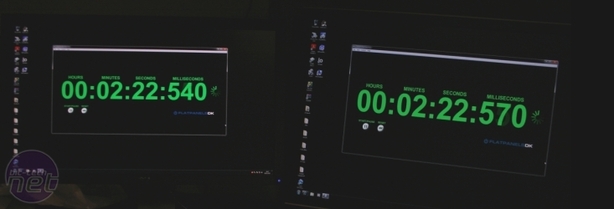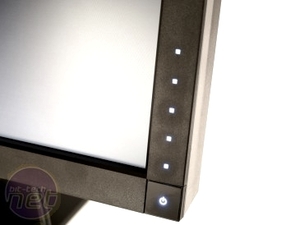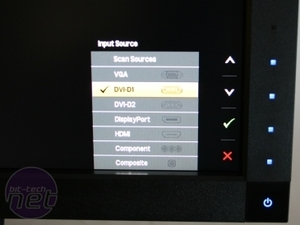Dell U2711 27inch Widescreen Monitor Review
March 16, 2010 | 08:47

More Specs and Image Quality
While the U2711 uses tried and tested cold cathode fluorescent lamps (CCFLs) and not LED-based back lighting, there's little light bleed, even at the edges, and a very even balance on black and white backgrounds. The 350cd/m2 brightness rating was more than enough with the default setting of 50.Dell was also keen to advertise the fact that the U2711 uses 12-bit internal processing. Combined with the very high colour gamut, the range of colours (especially greyscale tones) that the screen can display is greatly increased. The one significant benefactor of increased greyscale tones is no appearance of banding in dark portions of scenes, and we saw impressive results in our Serenity 1080p trailer and the gradient tests of the Lagom screen tests.
The large resolution of the U2711 did throw up one unexpected result – even the 1080p video looked a touch grainy and noisy as it had to scale up from 1,920 x 1,080 to the super-HD resolution of 2,560 x 1,440.
Moving back to the Lagom tests, the contrast of the screen was excellent at both the black and whites ends of the range, while viewing angles were simply out of this world too. Dell quotes 178 degrees for both horizontal and vertical, and we believe it. Not only does brightness barely suffer at the extremes of viewing angle, but colour showed little degradation too.
Colours on the U2711 were so clear and vibrant that some bit-techers argued that games looked too vibrant. For example, in Crysis, the laser pointers on the pistols were practically luminescent, and the red flare on the first level looked as if someone had dropped a real flare into the screen. The jungles of Crysis looked awe-inspiringly green, just as on the fantastic HP LP2475w. To change a famous slogan slightly, this is The Way It's Meant To Be Viewed...
The U2711 was equally brilliant for photo editing. A simple flick through our various Flickr albums had us rediscovering old photos that looked like they'd received a thorough Photoshop workout. The resolution is useful for tweaking images at actual size too, as 2,560 x 1,440 is essentially 3.5megapixels.
Input lag was a little higher than we would have liked, with the U2711 exhibiting a consistent lag of 30ms behind our practically lag-free Dell 3007WFP-HC control monitor, seen above on the right. This was ever so slightly noticeable in fast paced games, so if twitch-gaming is your thing, you might want to look elsewhere.
The response time of 6ms isn't as quick as you'll see from TN panel, but is very quick for the more vibrant IPS LCD technology. Even so, we couldn't see any noticeable ghosting or blur whilst playing Crysis or Quake Live.
The OSD was a mixed bag. On the downside, we really didn't like the layout of the buttons. It's far too easy to press the power button by accident, and the other buttons aren't particularly sensitive either. The GUI is actually well laid out though, with plenty of features on tap such as eight pre-set modes including Adobe RGB, sRGB and custom colour (which provides RGB tweaking). In addition to brightness and contrast, sharpness and dynamic contrast can be adjusted, as can the ability to turn off the annoying beep whenever you press a button.

MSI MPG Velox 100R Chassis Review
October 14 2021 | 15:04











Want to comment? Please log in.